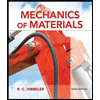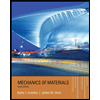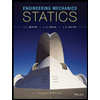
FUNDAMENTALS OF FLUID MECHANICS
8th Edition
ISBN: 9781119571490
Author: GERHART
Publisher: WILEY
expand_more
expand_more
format_list_bulleted
Question
Chapter 2.8, Problem 89P
To determine
The force on the latch is independent of the supply pressure and the height of the tank.
Expert Solution & Answer
Want to see the full answer?
Check out a sample textbook solution
Students have asked these similar questions
Qu. 13 What are the indices for the Direction 2 indicated by vector in the following sketch?
Qu. 14 Determine the indices for the direction A and B shown in the following cubic unit cell.
please show all work step by step from material engineering
The thin-walled open cross section shown is transmitting torque 7. The angle of twist ₁ per unit length of each leg can be
determined separately using the equation
01
=
3Ti
GLIC
3
where G is the shear modulus, ₁ is the angle of twist per unit length, T is torque, and L is the length of the median line.
In this case, i = 1, 2, 3, and T; represents the torque in leg i. Assuming that the angle of twist per unit length for each
leg is the same, show that
T= Lic³ and Tmaz = G01 Cmax
Consider a steel section with Tallow = 12.40 kpsi.
C1
2 mm
L1
20 mm
C2
3 mm
L2
30 mm
C3
2 mm
L3
25 mm
Determine the torque transmitted by each leg and the torque transmitted by the entire section.
The torque transmitted by the first leg is |
N-m.
The torque transmitted by the second leg is
N-m.
The torque transmitted by the third leg is
N-m.
The torque transmitted by the entire section is
N-m.
Please help, make sure it's to box out and make it clear what answers go where...
Chapter 2 Solutions
FUNDAMENTALS OF FLUID MECHANICS
Ch. 2.3 - Prob. 1PCh. 2.3 - The deepest known spot in the oceans is the...Ch. 2.3 - A closed tank is partially filled with glycerin....Ch. 2.3 - A 3-m-diameter vertical cylindrical tank is filled...Ch. 2.3 - Blood pressure is usually given as a ratio of the...Ch. 2.3 - An unknown immiscible liquid seeps into the bottom...Ch. 2.3 - A 30-ft-high downspout of a house is clogged at...Ch. 2.3 - How high a column of SAE 30 oil would be required...Ch. 2.3 - Bathyscaphes are capable of submerging to great...Ch. 2.3 - The deepest known spot in the oceans is the...
Ch. 2.3 - A submarine submerges by admitting seawater (S =...Ch. 2.3 - Determine the pressure at the bottom of an open...Ch. 2.3 - In a certain liquid at rest, measurements of the...Ch. 2.3 - Because of elevation differences, the water...Ch. 2.3 - Under normal conditions the temperature of the...Ch. 2.3 - Often young children drink milk (ρ = 1030 kg/m3)...Ch. 2.3 - (See The Wide World of Fluids article titled...Ch. 2.4 - What would be the barometric pressure reading, in...Ch. 2.4 - Denver, Colorado, is called the “mile-high city”...Ch. 2.4 - Prob. 20PCh. 2.4 - Pikes Peak near Denver, Colorado, has an elevation...Ch. 2.4 - Equation 2.12 provides the relationship between...Ch. 2.4 - As shown in Fig. 2.6 for the U.S. standard...Ch. 2.4 - (See The Wide World of Fluids article titled...Ch. 2.5 - On a given day, a barometer at the base of the...Ch. 2.5 - Aneroid barometers can be used to measure changes...Ch. 2.5 - Bourdon gages (see Video V2.4 and Fig. 2.13) are...Ch. 2.5 - On the suction side of a pump, a Bourdon pressure...Ch. 2.5 - A Bourdon pressure gage attached to the outside of...Ch. 2.6 - Obtain a photograph/image of a situation in which...Ch. 2.6 - A U-tube manometer is used to check the pressure...Ch. 2.6 - A barometric pressure of 29.4 in. Hg corresponds...Ch. 2.6 - For an atmospheric pressure of 101 kPa (abs)...Ch. 2.6 - The closed tank of Fig. P.2.34 is filled with...Ch. 2.6 - A mercury manometer is connected to a large...Ch. 2.6 - The U-tube manometer shown in Fig. P2.36 has two...Ch. 2.6 - A U-tube manometer is connected to a closed tank...Ch. 2.6 - The container shown in Fig. P2.38 holds 60 °F...Ch. 2.6 - A closed cylindrical tank filled with water has a...Ch. 2.6 - Two pipes are connected by a manometer as shown in...Ch. 2.6 - Find the percentage difference in the readings of...Ch. 2.6 - A U-tube manometer is connected to a closed tank...Ch. 2.6 - For the inclined-tube manometer of Fig. P2.43, the...Ch. 2.6 - A flowrate measuring device is installed in a...Ch. 2.6 - The sensitivity Sen of the micromanometer shown in...Ch. 2.6 - The cylindrical tank with hemispherical ends shown...Ch. 2.6 - Determine the elevation difference. Δh, between...Ch. 2.6 - What is the specific gravity of the liquid in the...Ch. 2.6 - For the configuration shown in Fig. P2.49 what...Ch. 2.6 - The manometer shown in Fig. P2.50 has an air...Ch. 2.6 - The U-tube manometer shown in Fig. P2.51 has legs...Ch. 2.6 - Both ends of the U-tube mercury manometer of Fig....Ch. 2.6 - The inverted U-tube manometer of Fig. P2.53...Ch. 2.6 - An inverted U-tube manometer containing oil (SG =...Ch. 2.6 - The sensitivity Sen of the manometer shown in Fig....Ch. 2.6 - In Fig. P2.56 pipe A contains gasoline (SG = 0.7),...Ch. 2.6 - The mercury manometer of Fig. P2.57 indicates a...Ch. 2.6 - Consider the cistern manometer shown in Fig....Ch. 2.6 - Prob. 59PCh. 2.6 - Prob. 60PCh. 2.6 - Determine the new differential reading along the...Ch. 2.6 - Prob. 62PCh. 2.6 - Determine the ratio of areas, A1/A2, of the two...Ch. 2.6 - Prob. 64PCh. 2.6 - Prob. 65PCh. 2.6 - An inverted hollow cylinder is pushed into the...Ch. 2.8 - Obtain a photograph/image of a situation in which...Ch. 2.8 - The basic elements of a hydraulic press are shown...Ch. 2.8 - The hydraulic cylinder shown in Fig. P2.69, with a...Ch. 2.8 - A Bourdon gage (see Fig. 2.13 and Video V2.4) is...Ch. 2.8 - A bottle jack allows an average person to lift one...Ch. 2.8 - Suction is often used in manufacturing processes...Ch. 2.8 - A piston having a cross-sectional area of 0.07 m2...Ch. 2.8 - Prob. 74PCh. 2.8 - The container shown in Fig. P2.75 has square cross...Ch. 2.8 - Find the weight W needed to hold the wall shown in...Ch. 2.8 - Determine the magnitude and direction of the force...Ch. 2.8 - An automobile has just dropped into a river. The...Ch. 2.8 - Consider the gate shown in Fig. P2.79. The gate is...Ch. 2.8 - Will the gate in Problem 44 ever open?
Ch. 2.8 - A tank contains 6 in. of oil (S = 0.82) above 6...Ch. 2.8 - A structure is attached to the ocean floor as...Ch. 2.8 - Concrete is poured into the forms as shown in Fig....Ch. 2.8 - A long, vertical wall separates seawater from...Ch. 2.8 - Forms used to make a concrete basement wall are...Ch. 2.8 - While building a high, tapered concrete wall,...Ch. 2.8 - A homogeneous, 4-ft-wide, 8-ft-long rectangular...Ch. 2.8 - A gate having the shape shown in Fig. P2.88 is...Ch. 2.8 - A pump supplies water under pressure to a large...Ch. 2.8 - Prob. 90PCh. 2.8 - Prob. 91PCh. 2.8 - The dam shown in Fig. P2.92 is 200 ft long and is...Ch. 2.8 - Prob. 93PCh. 2.8 - Figure P2.94 is a representation of the Keswick...Ch. 2.8 - The Keswick dam in Problem 2.94 is made of...Ch. 2.8 - The Keswick dam in Problem 2.94 is made of...Ch. 2.8 - Prob. 97PCh. 2.8 - Prob. 98PCh. 2.8 - Find the magnitude and location of the net...Ch. 2.8 - Prob. 100PCh. 2.8 - Find the total vertical force on the cylinder...Ch. 2.8 - A 3-m-wide, 8-m-high rectangular gate is located...Ch. 2.8 - A gate having the cross section shown in Fig....Ch. 2.8 - The massless, 4-ft-wide gate shown in Fig. P2.104...Ch. 2.8 - A 200-lb homogeneous gate 10 ft wide and 5 ft long...Ch. 2.8 - An open tank has a vertical partition and on one...Ch. 2.8 - Prob. 107PCh. 2.8 - A 4-ft by 3-ft massless rectangular gate is used...Ch. 2.8 - A thin 4-ft-wide, right-angle gate with negligible...Ch. 2.8 - The closed vessel of Fig. P2.110 contains water...Ch. 2.8 - (See The Wide World of Fluids article titled “The...Ch. 2.10 - Obtain a photograph/image of a situation in which...Ch. 2.10 - Prob. 113PCh. 2.10 - Prob. 114PCh. 2.10 - Figure P2.115 shows a cross section of a submersed...Ch. 2.10 - The container shown in Fig. P2.116 has circular...Ch. 2.10 - The 18-ft-long lightweight gate of Fig. P2.117 is...Ch. 2.10 - The air pressure in the top of the 2-liter pop...Ch. 2.10 - In drilling for oil in the Gulf of Mexico, some...Ch. 2.10 -
Hoover Dam (see Video 2.5) is the highest...Ch. 2.10 - A plug in the bottom of a pressurized tank is...Ch. 2.10 -
The homogeneous gate shown in Fig. P2.122...Ch. 2.10 - The concrete (specific weight = 150 lb/ft3)...Ch. 2.10 - Prob. 124PCh. 2.10 - Find the magnitude, direction, and location of the...Ch. 2.10 - A 10-m-long log is stuck against a dam, as shown...Ch. 2.10 - Prob. 127PCh. 2.10 - Prob. 128PCh. 2.10 - Prob. 129PCh. 2.10 - Prob. 130PCh. 2.10 - Prob. 131PCh. 2.11 - Prob. 132PCh. 2.11 - An iceberg (specific gravity 0.917) floats in the...Ch. 2.11 - Prob. 134PCh. 2.11 - Prob. 135PCh. 2.11 - Prob. 136PCh. 2.11 - Prob. 137PCh. 2.11 - Prob. 138PCh. 2.11 - Estimate the minimum water depth needed to float a...Ch. 2.11 - Prob. 140PCh. 2.11 - Prob. 141PCh. 2.11 - Prob. 142PCh. 2.11 - Prob. 143PCh. 2.11 - A solid cylindrical pine (S = 0.50) spar buoy has...Ch. 2.11 - Prob. 145PCh. 2.11 - Prob. 146PCh. 2.11 - Prob. 147PCh. 2.11 - A submarine is modeled as a cylinder with a length...Ch. 2.12 - Prob. 149PCh. 2.12 - Prob. 150PCh. 2.12 - Prob. 151PCh. 2.12 - Prob. 152PCh. 2.12 - Prob. 153PCh. 2.12 - The cylinder in Fig. P2.154 accelerates to the...Ch. 2.12 - A closed cylindrical tank that is 8 ft in diameter...Ch. 2.12 - The cart shown in Fig. P2.156 measures 10.0 cm...Ch. 2.12 - The U-tube manometer in Fig. P2.157 is used to...Ch. 2.12 - Prob. 158PCh. 2.12 - An open 1-m-diameter tank contains water at a...Ch. 2.12 - Prob. 160PCh. 2.12 - Prob. 161PCh. 2.12 - Prob. 162PCh. 2.12 - Prob. 163P
Knowledge Booster
Learn more about
Need a deep-dive on the concept behind this application? Look no further. Learn more about this topic, mechanical-engineering and related others by exploring similar questions and additional content below.Similar questions
- The cylinder floats in the water and oil to the level shown. Determine the weight of the cylinder. (rho)o=910 kg/m^3arrow_forwardPlease help, make sure it's to box out and make it clear what answers go where..arrow_forwardPlease help, make sure it's to box out and make it clear what answers go where...arrow_forward
- Please help, make sure it's to box out and make it clear what answers go where...arrow_forwardA triangular distributed load of max intensity w acts on beam AB. The beam is supported by a pin at A and member CD, which is connected by pins at C and D respectively. Determine the largest load intensity, Wmax, that can be applied if the pin at D can support a maximum force of 18000 N. Also determine the reactions at A and C and express each answer in Cartesian components. Assume the masses of both beam and member ✓ are negligible. Dwas шал = A BY NC SA 2016 Eric Davishahl C D -a- Ур -b- X B W Values for dimensions on the figure are given in the following table. Note the figure may not be to scale. Variable Value a 6.6 m b 11.88 m C 4.29 m The maximum load intensity is = wmax N/m. The reaction at A is A = The reaction at C is = i+ Ĵ N. ĴN. 12 i+arrow_forwardThe beam is supported by a pin at B and a roller at C and is subjected to the loading shown with w =110 lb/ft, and F 205 lb. a.) If M = 2,590 ft-lb, determine the support reactions at B and C. Report your answers in both Cartesian components. b.) Determine the largest magnitude of the applied couple M for which the beam is still properly supported in equilibrium with the pin and roller as shown. 2013 Michael Swanbom CC BY NC SA M ру W B⚫ C F ka b Values for dimensions on the figure are given in the following table. Note the figure may not be to scale. Variable Value a 3.2 ft b 6.4 ft C 3 ft a.) The reaction at B is B = The reaction at C is C = ĵ lb. i+ Ĵ lb. b.) The largest couple that can be applied is M ft-lb. == i+arrow_forward
- The beam ABC has a mass of 79.0 kg and is supported by the rope BDC that runs through the frictionless pulley at D . The winch at C has a mass of 36.5 kg. The tension in the rope acts on the beam at points B and C and counteracts the moments due to the beam's weight (acting vertically at the midpoint of its length) and the weight of the winch (acting vertically at point C) such that the resultant moment about point A is equal to zero. Assume that rope segment CD is vertical and note that rope segment BD is NOT necessarily perpendicular to the beam. a.) Compute the tension in the rope. b.) Model the two forces the rope exerts on the beam as a single equivalent force and couple moment acting at point B. Enter your answer in Cartesian components. c.) Model the two forces the rope exerts on the beam as a single equivalent force (no couple) and determine the distance from A to the point along the beam where the equivalent force acts (measured parallel to the beam from A ). Enter your answer…arrow_forwardw1 Three distributed loads act on a beam as shown. The load between A and B increases linearly from 0 to a maximum intensity of w₁ = 12.8 lb/ft at point B. The load then varies linearly with a different slope to an intensity of w₂ = 17.1 lb/ft at C. The load intensity in section CD of the beam is constant at w3 10.2 lb/ft. For each load region, determine the resultant force and the location of its line of action (distance to the right of A for all cases). cc 10 BY NC SA 2016 Eric Davishahl = WI W2 W3 -b- C Values for dimensions on the figure are given in the following table. Note the figure may not be to scale. Variable Value a 4.50 ft b 5.85 ft с 4.28 ft The resultant load in region AB is FR₁ = lb and acts ft to the right of A. The resultant load in region BC is FR2 lb and acts = ft to the right of A. The resultant load in region CD is FR3 = lb and acts ft to the right of A.arrow_forwardThe T-shaped structure is embedded in a concrete wall at A and subjected to the force F₁ and the force-couple system F2 1650 N and M = 1,800 N-m at the locations shown. Neglect the weight of the structure in your calculations for this problem. = a.) Compute the allowable range of magnitudes for F₁ in the direction shown if the connection at A will fail when subjected to a resultant moment with a magnitude of 920 N- m or higher. b.) Focusing on the forces and igonoring given M for now. Using the value for F1, min that you calculated in (a), replace the two forces F₁ and F2 with a single force that has equivalent effect on the structure. Specify the equivalent →> force Feq in Cartesian components and indicate the horizontal distance from point A to its line of action (note this line of action may not intersect the structure). c.) Now, model the entire force system (F1,min, F2, and M) as a single force and couple acting at the junction of the horizontal and vertical sections of the…arrow_forward
- The heated rod from Problem 3 is subject to a volumetric heating h(x) = h0 x L in units of [Wm−3], as shown in the figure below. Under the heat supply the temperature of the rod changes along x with the temperature function T (x). The temperature T (x) is governed by the d following equations: − dx (q(x)) + h(x) = 0 PDE q(x) =−k dT dx Fourier’s law of heat conduction (4) where q(x) is the heat flux through the rod and k is the (constant) thermal conductivity. Both ends of the bar are in contact with a heat reservoir at zero temperature. Determine: 1. Appropriate BCs for this physical problem. 2. The temperature function T (x). 3. The heat flux function q(x). Side Note: Please see that both ends of bar are in contact with a heat reservoir at zero temperature so the boundary condition at the right cannot be du/dx=0 because its not thermally insulated. Thank youarrow_forwardThe elastic bar from Problem 1 spins with angular velocity ω about an axis, as shown in the figure below. The radial acceleration at a generic point x along the bar is a(x) = ω2x. Under this radial acceleration, the bar stretches along x with displacement function u(x). The displacement d u(x) is governed by the following equations: dx (σ(x)) + ρa(x) = 0 PDE σ(x) = E du dx Hooke’s law (2) where σ(x) is the axial stress in the rod, ρ is the mass density, and E is the (constant) Young’s modulus. The bar is pinned on the rotation axis at x = 0 and it is also pinned at x = L. Determine: 1. Appropriate BCs for this physical problem. 2. The displacement function u(x). 3. The stress function σ(x). SIDE QUESTION: I saw a tutor solve it before but I didn't understand why the tutor did not divide E under the second term (c1x) before finding u(x). The tutor only divided E under first term. please explain and thank youarrow_forwardcalculate the total power required to go 80 mph in a VW Type 2 Samba Bus weighing 2310 lbs. with a Cd of 0.35 and a frontal area of 30ft^2. Consider the coefficient of rolling resistance to be 0.018. What is the increase in power required to go the same speed if the weight is increased by 2205 pounds (the rated carrying capacity of the vehicle). If the rated power for the vehicle is 49 bhp, will the van be able to reach 80 mph at full carrying capacity?arrow_forward
arrow_back_ios
SEE MORE QUESTIONS
arrow_forward_ios
Recommended textbooks for you
 Elements Of ElectromagneticsMechanical EngineeringISBN:9780190698614Author:Sadiku, Matthew N. O.Publisher:Oxford University Press
Elements Of ElectromagneticsMechanical EngineeringISBN:9780190698614Author:Sadiku, Matthew N. O.Publisher:Oxford University Press Mechanics of Materials (10th Edition)Mechanical EngineeringISBN:9780134319650Author:Russell C. HibbelerPublisher:PEARSON
Mechanics of Materials (10th Edition)Mechanical EngineeringISBN:9780134319650Author:Russell C. HibbelerPublisher:PEARSON Thermodynamics: An Engineering ApproachMechanical EngineeringISBN:9781259822674Author:Yunus A. Cengel Dr., Michael A. BolesPublisher:McGraw-Hill Education
Thermodynamics: An Engineering ApproachMechanical EngineeringISBN:9781259822674Author:Yunus A. Cengel Dr., Michael A. BolesPublisher:McGraw-Hill Education Control Systems EngineeringMechanical EngineeringISBN:9781118170519Author:Norman S. NisePublisher:WILEY
Control Systems EngineeringMechanical EngineeringISBN:9781118170519Author:Norman S. NisePublisher:WILEY Mechanics of Materials (MindTap Course List)Mechanical EngineeringISBN:9781337093347Author:Barry J. Goodno, James M. GerePublisher:Cengage Learning
Mechanics of Materials (MindTap Course List)Mechanical EngineeringISBN:9781337093347Author:Barry J. Goodno, James M. GerePublisher:Cengage Learning Engineering Mechanics: StaticsMechanical EngineeringISBN:9781118807330Author:James L. Meriam, L. G. Kraige, J. N. BoltonPublisher:WILEY
Engineering Mechanics: StaticsMechanical EngineeringISBN:9781118807330Author:James L. Meriam, L. G. Kraige, J. N. BoltonPublisher:WILEY

Elements Of Electromagnetics
Mechanical Engineering
ISBN:9780190698614
Author:Sadiku, Matthew N. O.
Publisher:Oxford University Press

Mechanics of Materials (10th Edition)
Mechanical Engineering
ISBN:9780134319650
Author:Russell C. Hibbeler
Publisher:PEARSON

Thermodynamics: An Engineering Approach
Mechanical Engineering
ISBN:9781259822674
Author:Yunus A. Cengel Dr., Michael A. Boles
Publisher:McGraw-Hill Education

Control Systems Engineering
Mechanical Engineering
ISBN:9781118170519
Author:Norman S. Nise
Publisher:WILEY

Mechanics of Materials (MindTap Course List)
Mechanical Engineering
ISBN:9781337093347
Author:Barry J. Goodno, James M. Gere
Publisher:Cengage Learning

Engineering Mechanics: Statics
Mechanical Engineering
ISBN:9781118807330
Author:James L. Meriam, L. G. Kraige, J. N. Bolton
Publisher:WILEY
Physics 33 - Fluid Statics (1 of 10) Pressure in a Fluid; Author: Michel van Biezen;https://www.youtube.com/watch?v=mzjlAla3H1Q;License: Standard YouTube License, CC-BY